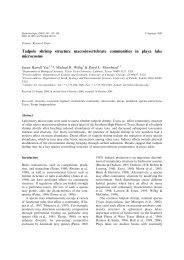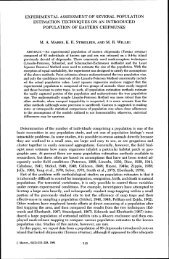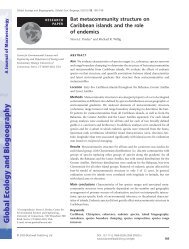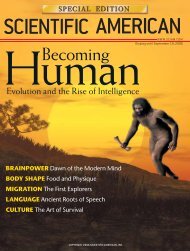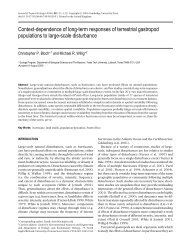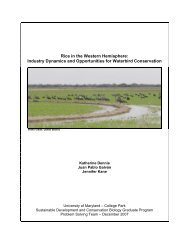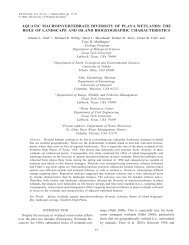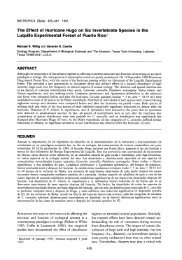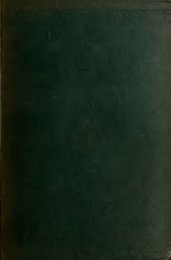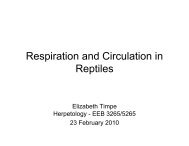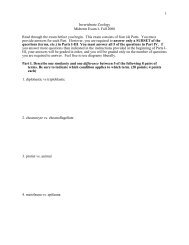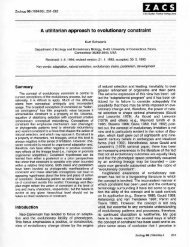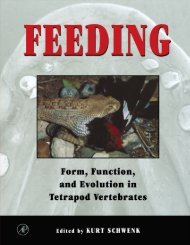Comparative biology and the importance of cladistic classification: a ...
Comparative biology and the importance of cladistic classification: a ...
Comparative biology and the importance of cladistic classification: a ...
You also want an ePaper? Increase the reach of your titles
YUMPU automatically turns print PDFs into web optimized ePapers that Google loves.
CLADISTIC CLASSIFICATION 75<br />
some species (Schwenk, 1993a), but it may be most important as a general<br />
exploratory sense that, along with vision, triggers tongue-flicking <strong>and</strong><br />
vomerolfaction (e.g. Cowles & Phelan, 1958; Duvall, 198 1 ; Halpern, 1992;<br />
Graves, 1993); (2) vomerolfaction seems most important in sensing more<br />
proximate <strong>and</strong> circumscribed chemical sources <strong>of</strong> lower volatility. It is clearly<br />
important in species <strong>and</strong> sex discrimination, sexual behaviour, <strong>and</strong> investigation<br />
<strong>of</strong> novel stimuli, in general. Vomerolfaction may have additional functions,<br />
particularly in snakes (e.g. Burghardt, 1970, 1980; Simon, 1983; Halpern, 1992).<br />
CLASSIFICATION AND CHEMORECEPTION<br />
A conjution <strong>and</strong> its consequences<br />
The <strong>cladistic</strong> <strong>classification</strong> <strong>of</strong> Squamata reflects a nested hierarchy <strong>of</strong> taxa in<br />
contrast to Camp’s ( 1923) fundamental dichotomy. As currently conceived, <strong>the</strong><br />
sensory <strong>biology</strong> <strong>of</strong> squamates is more accurately represented by <strong>the</strong> former than<br />
<strong>the</strong> latter. As such, <strong>the</strong>re is no obvious dichotomy in sensory modes, only lineage-<br />
specific combinations <strong>of</strong> traits expressing a continuum, <strong>of</strong> sorts (Schwenk,<br />
1993b). It is now clear that <strong>the</strong> gekkotans (Gekkonidae <strong>and</strong> Pygopodidae) are<br />
highly chemosensory <strong>and</strong> in most details are more similar to <strong>the</strong>ir fellow<br />
scleroglossans than <strong>the</strong>y are to iguanians (Schwenk, 1993a, b). It is particularly<br />
this relationship, <strong>cladistic</strong> <strong>and</strong> biological, that is misrepresented by Camp’s<br />
( 1923) association <strong>of</strong> gekkotans with iguanians in an inclusive, paraphyletic<br />
taxon, Ascalabota. And it is this misrepresentation, I argue below, that has<br />
particularly misled comparative biologists who have followed Camp’s<br />
<strong>classification</strong>.<br />
Although <strong>the</strong> basis for Camp’s (1923) division <strong>of</strong> squamates into Ascalabota<br />
<strong>and</strong> Autarchoglossa was anatomical, he recognized some correlates. The<br />
principal dichotomy noted by Camp was <strong>the</strong> presence among autarchoglossans<br />
<strong>of</strong> many limbless forms <strong>and</strong> <strong>the</strong> absence <strong>of</strong> such forms among ascalabotans. He<br />
believed that limblessness in <strong>the</strong> Autarchoglossa was ‘permitted’ by <strong>the</strong> presence<br />
<strong>of</strong> a particular abdominal muscle <strong>and</strong> that <strong>the</strong> absence <strong>of</strong> this muscle in <strong>the</strong><br />
Ascalabota precluded limblessness as a viable evolutionary strategy. According<br />
to Camp, <strong>the</strong> ascalabotan condition arose as a result <strong>of</strong> arboreal <strong>and</strong> climbing<br />
specialization with concomitant reduction <strong>of</strong> axial locomotory musculature.<br />
Thus we see in Camp (1923: 385) <strong>the</strong> first expression <strong>of</strong> a biological dichotomy<br />
based on his own paraphyletic <strong>classification</strong>: ascalabotans as largely arboreal, or<br />
at least, climbing lizards <strong>and</strong> autarchoglossans as terrestrial lizards tending<br />
toward “worm-like burrowing, or a limbless, snake-like, grass-living habitus.”<br />
Camp (1923) made no reference to chemoreception, although he has been<br />
incorrectly attributed with this connection (e.g. Simon, 1983). He believed, like<br />
most o<strong>the</strong>rs at <strong>the</strong> time, that tongue-flicking was a tactile, not a chemosensory,<br />
behaviour (see Camp, 1923: 374).<br />
Twenty-five years later, Pratt (1948) published a comparative study <strong>of</strong> <strong>the</strong><br />
lizard nasal capsule <strong>and</strong> <strong>the</strong> relative development <strong>of</strong> <strong>the</strong> olfactory <strong>and</strong><br />
vomeronasal organs. He made no reference to Camp’s (1923) <strong>classification</strong>,<br />
focusing instead on <strong>the</strong> relationship between nasal capsule form (i.e.<br />
chemosensory development) <strong>and</strong> habitat. Pratt (1948: 183) suggested that <strong>the</strong>re is<br />
a trade-<strong>of</strong>f between ‘eye specialization’ <strong>and</strong> development <strong>of</strong> <strong>the</strong> olfactory



